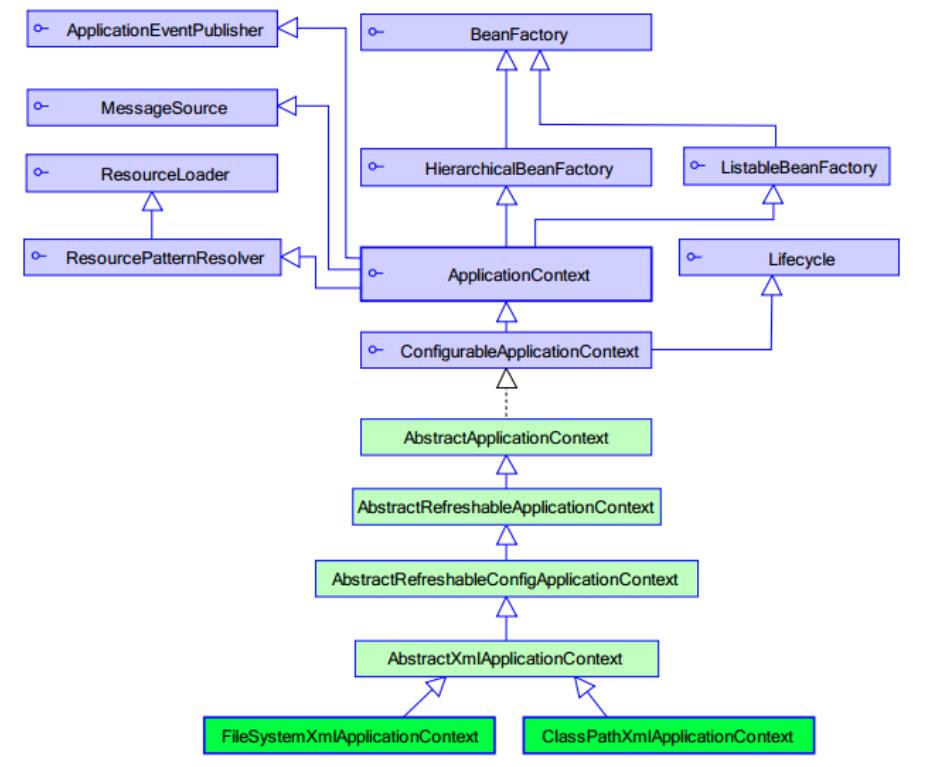Spring笔记
Posted ABO
tags:
篇首语:本文由小常识网(cha138.com)小编为大家整理,主要介绍了Spring笔记相关的知识,希望对你有一定的参考价值。
Spring的框架组成:它是对web层、业务层、数据访问层的每层都有解决方案;web层:Spring MVC;持久层:JDBC Template ;
业务层:Spring的Bean管理(类的实例化托管给Spring,即Ioc,Spring利用动态代理给类进行增强,即AOP;从另一个角色看,对象都是你Spring管理的,那将来对这些对象进行修改,你Spring部应该负责到底吗?);
首先知道,实现AOP的方法有很多,Spring默认使用JDK动态代理,在需要代理类而不是代理接口的时候,Spring会自动切换为使用CGLIB代理,不过现在的项目都是面向接口编程,所以JDK动态代理相对来说用的还是多一些。

一、核心部分之IOC
1.1 相关概念 IOC:控制反转:将对象的创建权由Spring管理。 DI:依赖注入:在Spring创建对象的过程中,把对象依赖的属性注入到类中。

ApplicationContext 应用上下文,加载Spring 框架配置文件; ApplicationContext类继承了BeanFactory;BeanFactory在使用到这个类的时候,getBean()方法的时候才会加载这个类而ApplicationContext类加载配置文件的时候,创建所有的类;ApplicationContext对BeanFactory提供了扩展: 国际化处理、事件传递、Bean自动装配、各种不同应用层的Context实现;早期开发使用BeanFactory。

下面为ApplicationContext加载配置文件的两个子类:

new ClassPathXmlApplicationContext("applicationContext.xml");加载classpath下面配置文件。 new FileSystemXmlApplicationContext("applicationContext.xml");加载磁盘下配置文件。
1.2 IOC实例;前提,导入相关jar包。接口:HelloService.java

public interface HelloService { public void sayHello(); }
接口实现类:HelloServiceImpl.java

public class HelloServiceImpl implements HelloService { private String info; public void setInfo(String info) { this.info = info; } public void sayHello() { System.out.println("Hello Spring..."+info); } }
配置文件:applicationContext.xml

<?xml version="1.0" encoding="UTF-8"?> <beans xmlns="http://www.springframework.org/schema/beans" xmlns:p="http://www.springframework.org/schema/p" xmlns:xsi="http://www.w3.org/2001/XMLSchema-instance" xsi:schemaLocation=" http://www.springframework.org/schema/beans http://www.springframework.org/schema/beans/spring-beans.xsd"> <!-- 通过一个<bean>标签设置类的信息,通过id属性为类起个标识. --> <bean id="userService" class="cn.itcast.spring3.demo1.HelloServiceImpl"> <!-- 使用<property>标签注入属性 --> <property name="info" value="传智播客"/> </bean> </beans>
测试: SpringTest1.java

public class SpringTest1 { @Test // 传统方式 public void demo1() { // 造成程序紧密耦合. HelloService helloService = new HelloServiceImpl(); helloService.sayHello(); } @Test // Spring开发 public void demo2() { // 创建一个工厂类. ApplicationContext applicationContext = new ClassPathXmlApplicationContext( "applicationContext.xml"); HelloService helloService = (HelloService) applicationContext .getBean("userService"); helloService.sayHello(); } @Test // 加载磁盘路径下的配置文件: public void demo3() { ApplicationContext applicationContext = new FileSystemXmlApplicationContext( "applicationContext.xml"); HelloService helloService = (HelloService) applicationContext .getBean("userService"); helloService.sayHello(); } @Test public void demo4(){ // ClassPathResource FileSystemResource BeanFactory beanFactory = new XmlBeanFactory(new FileSystemResource("applicationContext.xml")); HelloService helloService = (HelloService) beanFactory.getBean("userService"); helloService.sayHello(); } }
1.3 IOC装配Bean
1- Spring提供三种装配Bean的方法:构造方法实例化(默认无参数)、静态工厂实例化、实例工厂实例化

<!-- 默认情况下使用的就是无参数的构造方法. --> <bean id="bean1" class="cn.itcast.spring3.demo2.Bean1"></bean> <!-- 第二种使用静态工厂实例化 --> <bean id="bean2" class="cn.itcast.spring3.demo2.Bean2Factory" factory-method="getBean2"></bean> <!-- 第三种使用实例工厂实例化 --> <bean id="bean3" factory-bean="bean3Factory" factory-method="getBean3"></bean> <bean id="bean3Factory" class="cn.itcast.spring3.demo2.Bean3Factory"/>
2- Bean的配置

1- id和name的区别: id遵守XML约束的id的约束.id约束保证这个属性的值是唯一的,而且必须以字母开始,可以使用字母、数字、连字符、下划线、句话、冒号 name没有这些要求 ***** 如果bean标签上没有配置id,那么name可以作为id. ***** 开发中Spring和Struts1整合的时候, /login. <bean name=”/login” class=””> 现在的开发中都使用id属性即可. 2-类的作用范围: scope属性 : * singleton :单例的.(默认的值.) * prototype :多例的. * request :web开发中.创建了一个对象,将这个对象存入request范围,request.setAttribute(); * session :web开发中.创建了一个对象,将这个对象存入session范围,session.setAttribute(); * globalSession :一般用于Porlet应用环境.指的是分布式开发.不是porlet环境,globalSession等同于session; 实际开发中主要使用singleton,prototype 3-Bean的生命周期: 配置Bean的初始化和销毁的方法: 配置初始化和销毁的方法: * init-method=”setup” * destroy-method=”teardown” 执行销毁的时候,必须手动关闭工厂,而且只对scope=”singleton”有效. Bean的生命周期的11个步骤: 1.instantiate bean对象实例化 2.populate properties 封装属性 3.如果Bean实现BeanNameAware 执行 setBeanName 4.如果Bean实现BeanFactoryAware 或者 ApplicationContextAware 设置工厂 setBeanFactory 或者上下文对象 setApplicationContext 5.如果存在类实现 BeanPostProcessor(后处理Bean) ,执行postProcessBeforeInitialization 6.如果Bean实现InitializingBean 执行 afterPropertiesSet 7.调用<bean init-method="init"> 指定初始化方法 init 8.如果存在类实现 BeanPostProcessor(处理Bean) ,执行postProcessAfterInitialization 9.执行业务处理 10.如果Bean实现 DisposableBean 执行 destroy 11.调用<bean destroy-method="customerDestroy"> 指定销毁方法 customerDestroy 在CustomerService类的add方法之前进行权限校验?
Spring生命周期 示例:接口CustomerService.java

public interface CustomerService { public void add(); public void find(); }
CustomerServiceImpl.java

import org.springframework.beans.BeansException; import org.springframework.beans.factory.BeanNameAware; import org.springframework.beans.factory.DisposableBean; import org.springframework.beans.factory.InitializingBean; import org.springframework.context.ApplicationContext; import org.springframework.context.ApplicationContextAware; public class CustomerServiceImpl implements CustomerService, BeanNameAware,ApplicationContextAware,InitializingBean,DisposableBean { private String name; public void setName(String name) { System.out.println("第二步:属性的注入."); this.name = name; } public CustomerServiceImpl() { super(); System.out.println("第一步:实例化类."); } public void add(){ System.out.println("添加客户..."); } public void find(){ System.out.println("查询客户..."); } public void setBeanName(String name) { System.out.println("第三步:注入配置的类的名称"+name); } public void setApplicationContext(ApplicationContext applicationContext) throws BeansException { System.out.println("第四步:注入applicationContext"+applicationContext); } public void afterPropertiesSet() throws Exception { System.out.println("第六步:属性设置后执行..."); } public void setup(){ System.out.println("第七步:调用手动设置的初始化方法..."); } public void destroy() throws Exception { System.out.println("第十步:调用销毁的方法..."); } public void teardown(){ System.out.println("第十一步:调用手动销毁方法..."); } }
MyBeanPostProcessor.java

import java.lang.reflect.InvocationHandler; import java.lang.reflect.Method; import java.lang.reflect.Proxy; import org.springframework.beans.BeansException; import org.springframework.beans.factory.config.BeanPostProcessor; public class MyBeanPostProcessor implements BeanPostProcessor{ /** * bean:实例对象 * beanName:在配置文件中配置的类的标识. */ public Object postProcessBeforeInitialization(Object bean, String beanName) throws BeansException { System.out.println("第五步:初始化之前执行..."); return bean; } public Object postProcessAfterInitialization(final Object bean, String beanName) throws BeansException { System.out.println("第八步:初始化后执行..."); // 动态代理: if(beanName.equals("customerService")){ Object proxy = Proxy.newProxyInstance(bean.getClass().getClassLoader(), bean.getClass().getInterfaces() , new InvocationHandler() { // 调用目标方法的时候,调用invoke方法. public Object invoke(Object proxy, Method method, Object[] args) throws Throwable { if("add".equals(method.getName())){ System.out.println("权限校验..."); Object result = method.invoke(bean, args); //System.out.println(System.currentTimeMillis()); return result; } return method.invoke(bean, args); } }); return proxy; } return bean; } }
配置文件:applicationContext.xml

<?xml version="1.0" encoding="UTF-8"?> <beans xmlns="http://www.springframework.org/schema/beans" xmlns:p="http://www.springframework.org/schema/p" xmlns:xsi="http://www.w3.org/2001/XMLSchema-instance" xsi:schemaLocation=" http://www.springframework.org/schema/beans http://www.springframework.org/schema/beans/spring-beans.xsd"> <bean id="customerService" class="cn.itcast.spring3.demo4.CustomerServiceImpl" init-method="setup" destroy-method="teardown"> <property name="name" value="itcast"></property> </bean> <bean class="cn.itcast.spring3.demo4.MyBeanPostProcessor"></bean> </beans>
测试SpringTest4.java

import org.junit.Test; import org.springframework.context.support.ClassPathXmlApplicationContext; public class SpringTest4 { @Test // Bean完整的生命周期 public void demo1() { ClassPathXmlApplicationContext applicationContext = new ClassPathXmlApplicationContext( "applicationContext.xml"); CustomerService customerService = (CustomerService) applicationContext.getBean("customerService"); customerService.add(); customerService.find(); applicationContext.close(); } }
结果示例: 
3- Bean属性注入

使用配置文件注入:

1-Bean中属性注入:Spring支持构造方法注入和setter方法注入: * 构造器注入: <bean id="car" class="cn.itcast.spring3.demo5.Car"> <!-- <constructor-arg name="name" value="宝马"/> <constructor-arg name="price" value="1000000"/> --> <constructor-arg index="0" type="java.lang.String" value="奔驰"/> <constructor-arg index="1" type="java.lang.Double" value="2000000"/> </bean> * setter方法注入: <bean id="car2" class="cn.itcast.spring3.demo5.Car2"> <!-- <property>标签中name就是属性名称,value是普通属性的值,ref:引用其他的对象 --> <property name="name" value="保时捷"/> <property name="price" value="5000000"/> </bean> * setter方法注入对象属性:<property name="car2" ref="car2"/> * 名称空间p:注入属性: Spring2.5版本引入了名称空间p. p:<属性名>="xxx" 引入常量值 p:<属性名>-ref="xxx" 引用其它Bean对象.引入名称空间: <beans xmlns="http://www.springframework.org/schema/beans" xmlns:p="http://www.springframework.org/schema/p" xmlns:xsi="http://www.w3.org/2001/XMLSchema-instance" xsi:schemaLocation=" http://www.springframework.org/schema/beans http://www.springframework.org/schema/beans/spring-beans.xsd"> <bean id="car2" class="cn.itcast.spring3.demo5.Car2" p:name="宝马" p:price="400000"/> <bean id="person" class="cn.itcast.spring3.demo5.Person" p:name="童童" p:car2-ref="car2"/> * SpEL:属性的注入: Spring3.0提供注入属性方式:语法:#{表达式}<bean id="" value="#{表达式}"> <bean id="car2" class="cn.itcast.spring3.demo5.Car2"> <property name="name" value="#{\'大众\'}"></property> <property name="price" value="#{\'120000\'}"></property> </bean> <bean id="person" class="cn.itcast.spring3.demo5.Person"> <!--<property name="name" value="#{personInfo.name}"/>--> <property name="name" value="#{personInfo.showName()}"/> <property name="car2" value="#{car2}"/> </bean> <bean id="personInfo" class="cn.itcast.spring3.demo5.PersonInfo"> <property name="name" value="张三"/> </bean> 2-集合属性的注入: <bean id="collectionBean" class="cn.itcast.spring3.demo6.CollectionBean"> <!-- 注入List集合 --> <property name="list"> <list> <value>童童</value> <value>小凤</value> </list> </property> <!-- 注入set集合 --> <property name="set"> <set> <value>杜宏</value> <value>如花</value> </set> </property> <!-- 注入map集合 --> <property name="map"> <map> <entry key="刚刚" value="111"/> <entry key="娇娇" value="333"/> </map> </property> <property name="properties"> <props> <prop key="username">root</prop> <prop key="password">123</prop> </props> </property> </bean>
4-加载配置文件

第一种写法:ApplicationContext applicationContext = new ClassPathXmlApplicationContext("bean1.xml",”bean2.xml”); 第二种方法: <import resource="applicationContext2.xml"/>
5- 使用注解装配Bean spring使用JavaConfig进行配置

pring的注解装配Bean:
Spring2.5 引入使用注解去定义Bean;@Component 描述Spring框架中Bean
Spring的框架中提供了与@Component注解等效的三个注解:
@Repository 用于对DAO实现类进行标注
@Service 用于对Service实现类进行标注
@Controller 用于对Controller实现类进行标注
***** 三个注解为了后续版本进行增强的.
Bean的属性注入:
普通属性;
@Value(value="itcast")
private String info;
对象属性:
@Autowired:自动装配默认使用类型注入.
@Autowired
@Qualifier("userDao") --- 按名称进行注入.
@Autowired
@Qualifier("userDao")
private UserDao userDao;
等价于
@Resource(name="userDao")
private UserDao userDao;
Bean其他的属性的配置
配置Bean初始化方法和销毁方法:
* init-method 和 destroy-method.
@PostConstruct 初始化
@PreDestroy 销毁
配置Bean的作用范围: @Scope
Spring3.0提供使用Java类定义Bean信息的方法
@Configuration
public class BeanConfig {
@Bean(name="car")
public Car showCar(){
Car car = new Car();
car.setName("长安");
car.setPrice(40000d);
return car;
}
@Bean(name="product")
public Product initProduct(){
Product product = new Product();
product.setName("空调");
product.setPrice(3000d);
return product;
}
}
两种方式结合;一般使用XML注册Bean,使用注解进行属性的注入.
6- Spring整合Servlet

正常整合Servlet和Spring没有问题的但是每次执行Servlet的时候加载Spring配置,加载Spring环境. * 解决办法:在Servlet的init方法中加载Spring配置文件? * 当前这个Servlet可以使用,但是其他的Servlet的用不了了!!! * 将加载的信息内容放到ServletContext中.ServletContext对象时全局的对象.服务器启动的时候创建的.在创建ServletContext的时候就加载Spring的环境. * ServletContextListener:用于监听ServletContext对象的创建和销毁的. 导入;spring-web-3.2.0.RELEASE.jar 在web.xml中配置: <listener> <listener-class>org.springframework.web.context.ContextLoaderListener</listener-class> </listener> <context-param> <param-name>contextConfigLocation</param-name> <param-value>classpath:applicationContext.xml</param-value> </context-param> 修改程序的代码: WebApplicationContext applicationContext = WebApplicationContextUtils.getWebApplicationContext(getServletContext()); WebApplicationContext applicationContext = (WebApplicationContext) getServletContext().getAttribute(WebApplicationContext.ROOT_WEB_APPLICATION_CONTEXT_ATTRIBUTE);
二、核心部分之AOP
1.1 相关概念
AOP Aspect Oriented Programing 面向切面编程; AOP采取横向抽取机制,取代了传统纵向继承体系重复性代码(性能监视、事务管理、安全检查、缓存); Spring AOP使用纯Java实现,不需要专门的编译过程和类加载器,在运行期通过代理方式向目标类织入增强代码; AspecJ是一个基于Java语言的AOP框架,Spring2.0开始,Spring AOP引入对Aspect的支持,AspectJ扩展了Java语言,提供了一个专门的编译器,在编译时提供横向代码的织入。

以上是关于Spring笔记的主要内容,如果未能解决你的问题,请参考以下文章
